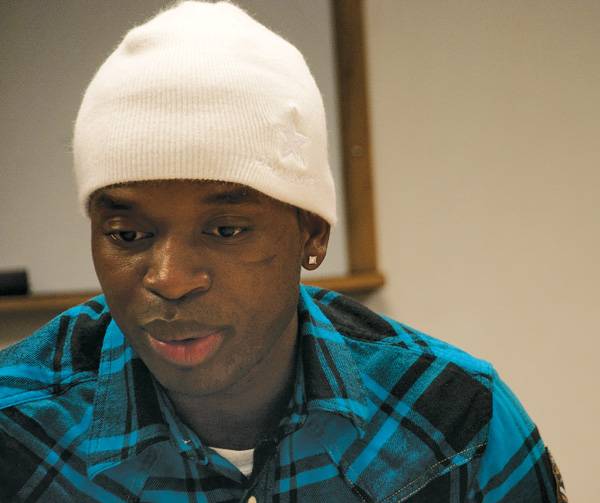Lifting the curse

Silentor Esthil-Henderson, senior in history.Photo: Karuna Ang/Iowa State Daily
November 16, 2009
It was a story Silentor Esthil-Henderson knew well.
An old man noticed a child picking up starfish off the beach and flinging them into the ocean. When the man asked why, the child responded that the starfish would die if left out in the sun.
“But there are millions of starfish and miles of beach,” the man said, “How can your effort make any difference?”
The child threw another starfish into the waves. “It made a difference to that one,” he said.
“I was one of those starfish,” said Esthil-Henderson, senior in history.
Weighing 36 pounds, 6-year-old Esthil-Henderson was diagnosed with osteomyelitis in LaCroix, Haiti, and was told he was never going to walk again. The doctors said he would not live to see the age of 7.
“I felt like I didn’t have an understanding of what was going on,” Esthil-Henderson said. “I was young. I was more or less suffering. All I knew I was in pain. I would sit and see the kids playing, and it would be sad because I couldn’t play, too.”
Osteomyelitis occurs when an infection from the bloodstream or another tissue reaches a bone, according to the Mayo Clinic. The infection often stems from malnutrition and must be treated aggressively to prevent the spread of the infection and to preserve the use of the bone.
Esthil-Henderson said Haitian hospitals did not have the medical supplies or qualified doctors to help his condition. He was confined to a bed until he was 8 when his family raised enough money for surgery.
They were told the only option was amputation.
“My parents didn’t want to see me in that condition, without a leg, so we didn’t do it,” Esthil-Henderson said.
Esthil-Henderson’s family turned to Haitian Vodou for help. In this practice, individuals ask deceased ancestors to heal.
But his condition worsened. The infection spread, and he continued to struggle with weight gain and mobility.
Out of desperation, Esthil-Henderson’s mother placed her son in a compound nearby where Christian missionaries were visiting.
“My mother had to turn to something that she didn’t believe in to find me help,” Esthil-Henderson said.
One of these missionaries was Tommy Henderson. As a registered nurse from Davenport visiting for one week, Henderson saw the boy crying and tried to aid him.
“My mother came out from where she was hiding. She fell to her knees and begged for help,” Esthil-Henderson said. “She didn’t know English and she cried and cried. [Henderson] knew what she was asking.”
Henderson took Esthil-Henderson from his mother and to several hospitals in Haiti. The verdict was the same at each: Esthil-Henderson had less than three months to live and his only chance of survival was amputation.
“[The doctors] told me not to waste my time with him because he was cursed from Vodou,” Henderson said. “Other doctors had surgically put dead animal parts in his leg to get rid of bad spirits, which is probably why the infection got worse. He was in bad shape.”
Henderson didn’t take no for an answer. He left Esthil-Henderson in the care of Haitian hospitals while he applied for a medical visa. Two months later, Henderson brought Esthil-Henderson to the U.S.
The University of Iowa Hospital told Esthil-Henderson that amputation was the best option as well, but Henderson would not let them operate.
Henderson admitted Esthil-Henderson into the Shriners Hospital for Children. At 9 years old, Esthil-Henderson still weighed 36 pounds and was bed-ridden.
This hospital, though, was different.
Esthil-Henderson began to recover from his ailment when he began his year at the Shriners Hospital.
After several treatments and physical therapy, Esthil-Henderson was able to walk without assistance.
“I owe the Shriners Hospital for the time they gave me. They never gave up on me,” Esthil-Henderson said. “The nurses treated me like their own kids and gave me the attention I needed to get better.”
Fifty-seven-year-old Henderson was a widower and felt a family environment would be best for Esthil-Henderson. After moving to three homes in the Davenport community, however, it became clear no household was a match for the 10-year-old.
“He was crying and was frustrated because he could not communicate with anyone,” Henderson said. “He looked at me and said, ‘No one wants me at home and no one wants me here.’ I told him it wasn’t true and that I wanted him. He’s legally been mine since, and I love him.”
Esthil-Henderson began school in the fourth grade. He did not know a word of English and was behind in coursework. Despite this, he felt empowered by education.
“I felt like my life began,” Esthil-Henderson said. “I got a new mind set. I started knowing things I never knew I could know. It was the first time I could think for myself.”
School was never easy for Esthil-Henderson as he progressed grade levels. Because he was so behind, Esthil-Henderson had a tutor for three hours each night after school.
“It was hard, but I stuck with it,” Esthil-Henderson said. “I felt like I didn’t want to let anybody down. I didn’t want to let myself down.”
Esthil-Henderson graduated from Bettendorf High School where he was active in athletics. He knew he needed good grades to play, which he said motivated him to keep his marks high.
Sometimes he won, Esthil-Henderson said, and sometimes he lost, but he never gave up. It was the same in “sports, school and life,” he said. “I kept pushing myself,” Esthil-Henderson said. “I like surprising the people that don’t think I can do it. I like surprising myself.”
Esthil-Henderson chose to attend Iowa State because he felt like he could be successful and everyone would be on his side to better the world. Upon applying, Esthil-Henderson received a full-tuition scholarship for minority students.
He chose a history major, because he thought teaching would be the best way to give back to a community.
“I wanted to be a teacher because of what all the teachers have done for me,” Esthil-Henderson said. “I feel like I could reach kids the way teachers reached me.”
Since arriving, however, Esthil-Henderson’s vision has changed. He felt teaching may limit the bigger picture. “America had one of the biggest struggles to become a powerful nation,” Esthil-Henderson said. “I can utilize what I know about U.S. history and get Haiti people to collaborate and overcome struggles of their own. I want to elevate the life of the people.”
Esthil-Henderson works as a seminar leader for minority students, is a Cyclone Aide and founded the Iowa State-Haiti Collaboration, a club dedicated to “inspire the life-long development for the families and children in LaCroix.”
Esthil-Henderson also is in the process of starting Hope on the Horizon, a nonprofit organization, similar to organizations like the Boys and Girls Club or YMCA for the people of Haiti.
“We specifically want to focus on women and want to give them the self confidence and tools they need to have a better life in Haiti,” he said.
Esthil-Henderson ultimately wants to see the children of Haiti be able to attend school and learn how to live a healthy life. The organization plans to provide “special projects where youth, parents, farmers, church leaders and preachers can become better equipped to face the challenges of daily life,” according to Hope on the Horizon’s blog.
Esthil-Henderson wants to bring health education, an English learning center and a resource library to LaCroix.
“Education is the key to any closed door,” he said. “Haiti is looking at a door made of steel.”
Esthil-Henderson, known as the “Haitian sensation” to his friends, is not taking on this task alone. He and other ISU students plan to give back to his roots.
He organized a mission trip that will travel to Haiti on Dec. 28–Jan. 4. Those traveling will construct a basketball court and soccer field for the children at the New Testament Church in LaCroix, the same place Esthil -Henderson was rescued.
“I shouldn’t wait until I’m in the business world to help. I can utilize younger minds to help what my people in Haiti are going through,” Esthil-Henderson said.
“He wants to help his people and I admire that,” Henderson said. “I am trying to help him every way I can.” The group is looking to raise $5,000 prior to departure. It currently has $1,500. “If we don’t get all the money, we’ll go — we’ll just do less,” Esthil-Henderson said.
Despite obstacles, Esthil-Henderson said he remains focused and takes each day as a challenge.
“If people doubt you, take it as a challenge,” Esthil-Henderson said. “You’re the only one who knows what you can do. All my life I was doubted — whether it was to survive another day, to do well in school. You have to fight any doubt. Making a difference for one person makes [the challenge] worth it.”
















